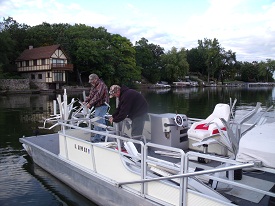- The process of restoring coho salmon habitat may get a bit easier for local landowners willing to undertake voluntary projects along Siskiyou County streams and rivers.
- By John Bowman Yreka, CA
 In 2010 the California Department of Fish and Game declared that two of the three brood years of Shasta River coho were functionally extinct, meaning there are no longer enough adults returning to the river in those years to sustain a viable population.
In 2010 the California Department of Fish and Game declared that two of the three brood years of Shasta River coho were functionally extinct, meaning there are no longer enough adults returning to the river in those years to sustain a viable population.- The process of restoring coho salmon habitat may get a bit easier for local landowners willing to undertake voluntary projects along Siskiyou County streams and rivers with the California legislature’s passage of Assembly Bill 1961, introduced by Assemblyman Jared Huffman (D–San Rafael). Dozens of unique habitat models at fishiding.comThe bill passed its final legislative hurdle on Aug. 27 with its approval by the California Assembly and now heads to the governor’s desk for his signature. First introduced in February, AB 1961 would expedite the approval process for voluntary habitat restoration projects by implementing a 30-day approval process and eliminating many of the usual regulatory hurdles for such in-stream projects.
“Coho salmon cannot afford to wait and neither can the communities where these restoration projects would provide much needed jobs,” said Huffman. “This bill lets us work together in a new way so that immediate actions can yield near-term results.”
Coho salmon generally have a three year life cycle. In 2010, the California Department of Fish and Game declared that two of the three brood years of Shasta River coho were functionally extinct, meaning there are no longer enough adults returning to the river in those years to sustain a viable population.
According to the text of the bill, “An urgency exists due to the extraordinarily small numbers of coho salmon remaining in California. In order to prevent their extinction from northern California waters, it is imperative that habitat restoration efforts be expedited and increased as soon as possible.”
Siskiyou County landowners and Resource Conservation Districts (RCDs) have cumulatively implemented millions of dollars worth of habitat restoration projects since coho were listed as threatened by both California and the federal Endangered Species Act in 1997. State and federal agencies say much more work must be done to aid the recovery of the species, though many landowners and stakeholders have complained that the permitting and regulatory processes create too many roadblocks.
AB 1961 directs state agencies to “expedite and streamline the permitting and approval of coho salmon habitat enhancement projects, including, in particular, large woody debris restoration projects, in northern California streams.”
The three main categories of projects eligible for the expedited process are as follows:
• Modification of existing water crossings for the purposes of eliminating a barrier to fish passage;
• Restoration of eroded or denuded streambanks by utilizing nonrock bioengineering practices and revegetating stream corridors with native riparian species; and
• Wood placement that benefits naturally reproducing fish stocks by creating or enhancing fish habitat, increasing stream complexity, or both.The bill stipulates, “Within 30 days after the [Department of Fish and Game] receives a written request to approve a coho salmon habitat enhancement project containing the information required pursuant to subdivision (c), the director shall determine whether the coho salmon habitat enhancement project is consistent with subdivision (a). If the director determines within that 30-day period, based upon substantial evidence, that the coho salmon enhancement project is consistent with subdivision (a), no further departmental approval shall be necessary.”
Executive director of the Scott River Water Trust Sari Sommarstrom has worked on many local habitat restoration projects and said, “Expediting state permitting was one of the few issues that everyone could agree on at the legislative hearing on coho last year. I’m glad that some cooperative progress in Sacramento was finally made, but the bill’s provisions are pretty limited. More progress from the state is still needed for those of us trying to help coho.”

